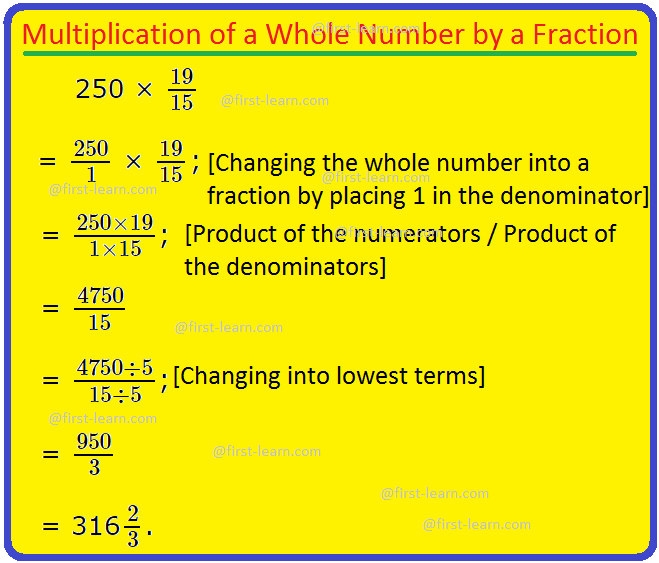Multiplication of a Whole Number by a Fraction
This topic discusses about multiplication of a whole number by a fraction. Whole numbers are positive integers starting from zero to infinity. The fractions are always in numerator and denominator form whereas, whole numbers are not. Hence a whole number has to be changed into numerator and denominator form for multiplying it with fraction.
In order to change whole number into fraction we have to take the whole number in the numerator and place 1 in the denominator. Now the numerator of the whole number is multiplied with the numerator of the fraction and denominator of the whole number is multiplied with the denominator of the fraction to get the result. That is (product of the numerators/product of the denominators)
Here are few examples to illustrate multiplication of a whole number by a fraction:
1. 5 × \(\frac{7}{10}\)
In this sum 5 is the whole number and \(\frac{7}{10}\) is the fraction.
Step I: Change the whole number into a fraction by placing 1 in the denominator.
Therefore, \(\frac{5}{1}\) × \(\frac{7}{10}\)
Step II: Now both the numbers are in fraction and the rule of multiplication of fractional number is that numerator and numerator should be multiplied and similarly denominator and denominator should be multiplied. So, we will do
5 × 7 = 35
And 1 × 10 = 10
Therefore, \(\frac{5}{1}\) × \(\frac{7}{10}\) = \(\frac{35}{10}\)
Step III: After multiplying numerator by numerator and denominator by denominator the answer that we will get has to be either changed into lowest term (if possible) and then change into mixed fraction if not a proper fraction or can be left as whole number (if possible).
Therefore, first we will change \(\frac{35}{10}\) into lowest term
= \(\frac{35 ÷ 5}{10 ÷ 5}\)
= \(\frac{7}{2}\)
2. 15 × 7\(\frac{2}{5}\)
= 15 × \(\frac{37}{5}\); [Changing mixed fraction into improper fraction]
= \(\frac{15}{1}\) × \(\frac{37}{5}\); [Changing the whole number into a fraction by placing 1 in the denominator]
= \(\frac{15 × 37}{1 × 5}\); [Product of the numerators/ product of the denominators]
= \(\frac{555}{5}\)
= \(\frac{555 ÷ 5}{5 ÷ 5}\); [Changing into lowest terms]
= 111
Explanation:
Here a whole number is multiplied with a mixed fraction. Hence we have to first change the mixed fraction into improper fraction for the purpose of calculation. Then change the whole number into a fraction by placing 1 in the denominator.
For changing 7\(\frac{2}{5}\) into a improper fraction we have to multiply the whole number 7 with the denominator 5. That is 7 × 5 = 35. With this 35 we will add the numerator that is 2 which gives 35 + 2 = 37. Now, 37 will be the numerator and 5 the denominator. Hence the fraction will be \(\frac{37}{5}\)
i.e. 7\(\frac{2}{5}\)
= \(\frac{7 × 5 + 2}{5}\)
= \(\frac{37}{5}\)
3. 250 × \(\frac{19}{15}\)
= \(\frac{250}{1}\) × \(\frac{19}{15}\); [Changing the whole number into a fraction by placing 1 in the denominator]
= \(\frac{250 × 19}{1 × 15}\); [Product of the numerators/ product of the denominators]
= \(\frac{4750}{15}\)
= \(\frac{4750 ÷ 5}{15 ÷ 5}\); [Changing into lowest terms]
= \(\frac{950}{3}\)
= 316\(\frac{2}{3}\).
From Multiplication is Repeated Addition to HOME PAGE
Recent Articles
-
What Is Plasma? | Blood Plasma | Proteins | Nutrients | Cholesterol
Nov 07, 25 10:29 AM
Blood is a mobile fluid which is a connective tissue and is derived from the mesoderm like cell any other connective tissue. Colour of blood is reddish and that flows inside the blood vessels by means… -
Disorders of Respiratory System | Tuberculosis | Pleurisy | Emphysema
Oct 28, 25 11:39 PM
Tuberculosis is very common disease and is caused by a type of bacteria called Mycobacterium tuberculosis. This disease causes different trouble in the respiration and infection of several parts of th… -
Regulation of Respiration | Respiratory Centres | Inspiratory Area |
Oct 14, 25 12:13 AM
Respiratory Centre is the area that controls the rate of respiration and it is observed to be located in medulla oblongata and pons. Respiratory Centre has the following will dispersed components like… -
Explain Transport of Gases | External Respiration | Tissue Respiration
Oct 09, 25 11:35 PM
In humans gaseous exchange is completed in the following ways the steps are - External Respiration or Breathing - Breathing in false taking in of Oxygen and giving out of carbon dioxide in the body. M… -
Kind and Number of Teeth | Location of Teeth in Mouth | Care of Teeth
Sep 11, 25 12:52 AM
Kind and Number of Teeth







New! Comments
Have your say about what you just read! Leave me a comment in the box below.